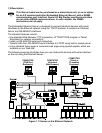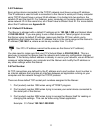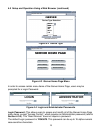
3.3 DHCP
DHCP, Dynamic Host Configuration Protocol enables individual computers or devices to
extract their IP configurations from a server (DHCP server). If the DHCP is enabled on
your iServer, as soon as the iServer is connected to the network, there is an exchange of
information between DHCP server and the iServer. During this process the IP address,
the Gateway address, and the Subnet Mask will be assigned to the iServer by the DHCP
server. Note that the DHCP server must be configured correctly to do such assignment.
If fixed or static IP address is desired, the DHCP must be disabled. The iServer is
shipped with DHCP disabled (factory default). The DHCP can be enabled by setting the
DIP switch # 3 to the “ON” position.
Figure 3.2 DIP Switch on the iServer
3.4 DNS
DNS, Domain Name System enables individual computers and devices to be recognized
over a network based on a specific name instead of an IP address. For example, instead
of having to use http://192.168.1.200 (IP address), you would use only http://eis03ec or
any eight character name stored as Host Name under Access Control menu in the
iServer Home Page. The default DNS name for an iServer is "eis" followed by the last
four digits of the MAC address of that particular iServer.
1. It is very important to communicate with the network administrator in order to
understand the DHCP and its existing configurations on the host server,
before enabling the DHCP on the iServer.
2. The iServers are shipped with a default static IP address of
192.168.1.200 and Subnet Mask of 255.255.255.0.
3. On Novell networks or Windows 2000 where the DCHP is an updated
function of DNS this feature may be beneficial since a particular name can be
assigned eliminating the need for the IP address, as described in Section 3.4.
10
10
1
4
3
2
OFF
ON
1
4
3
2
OFF
ON


















